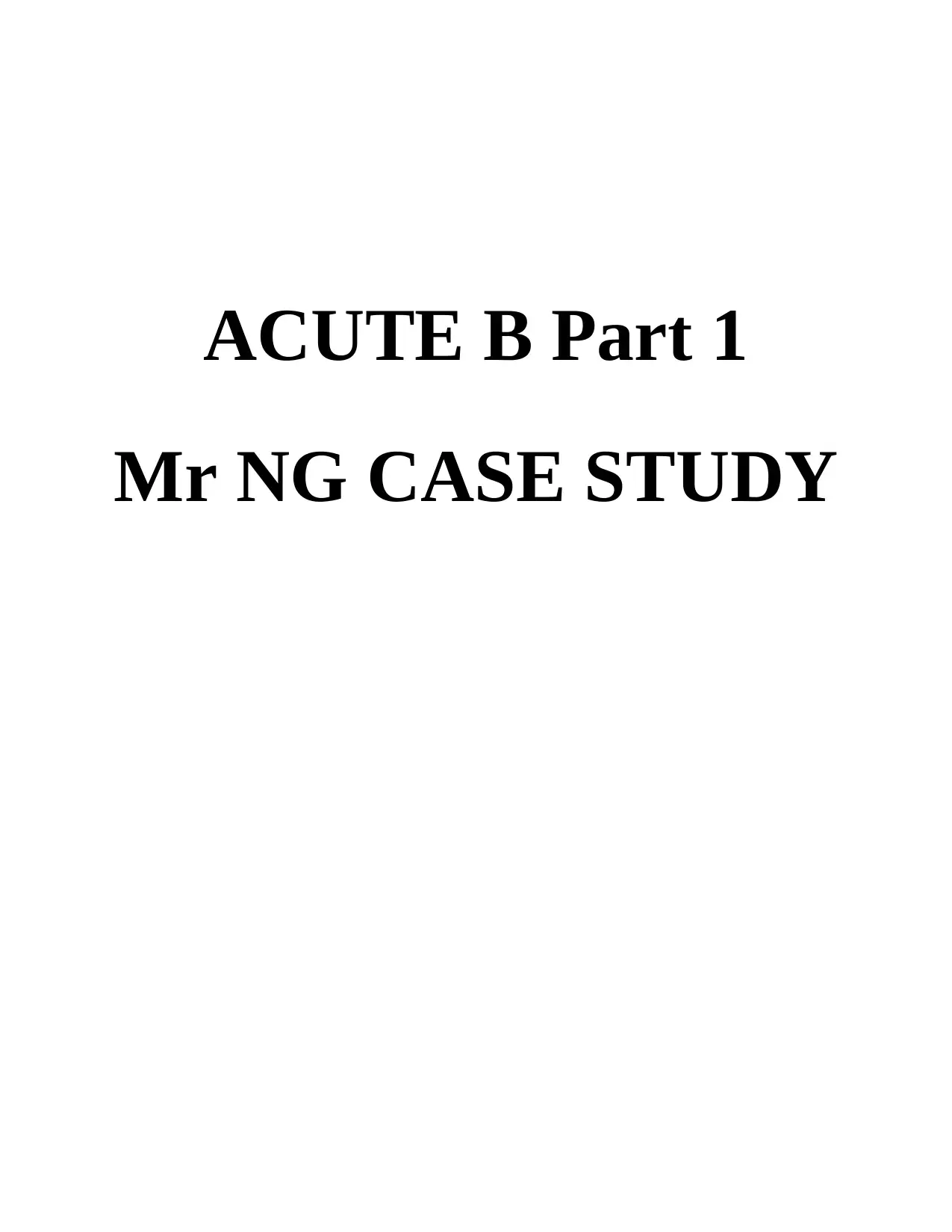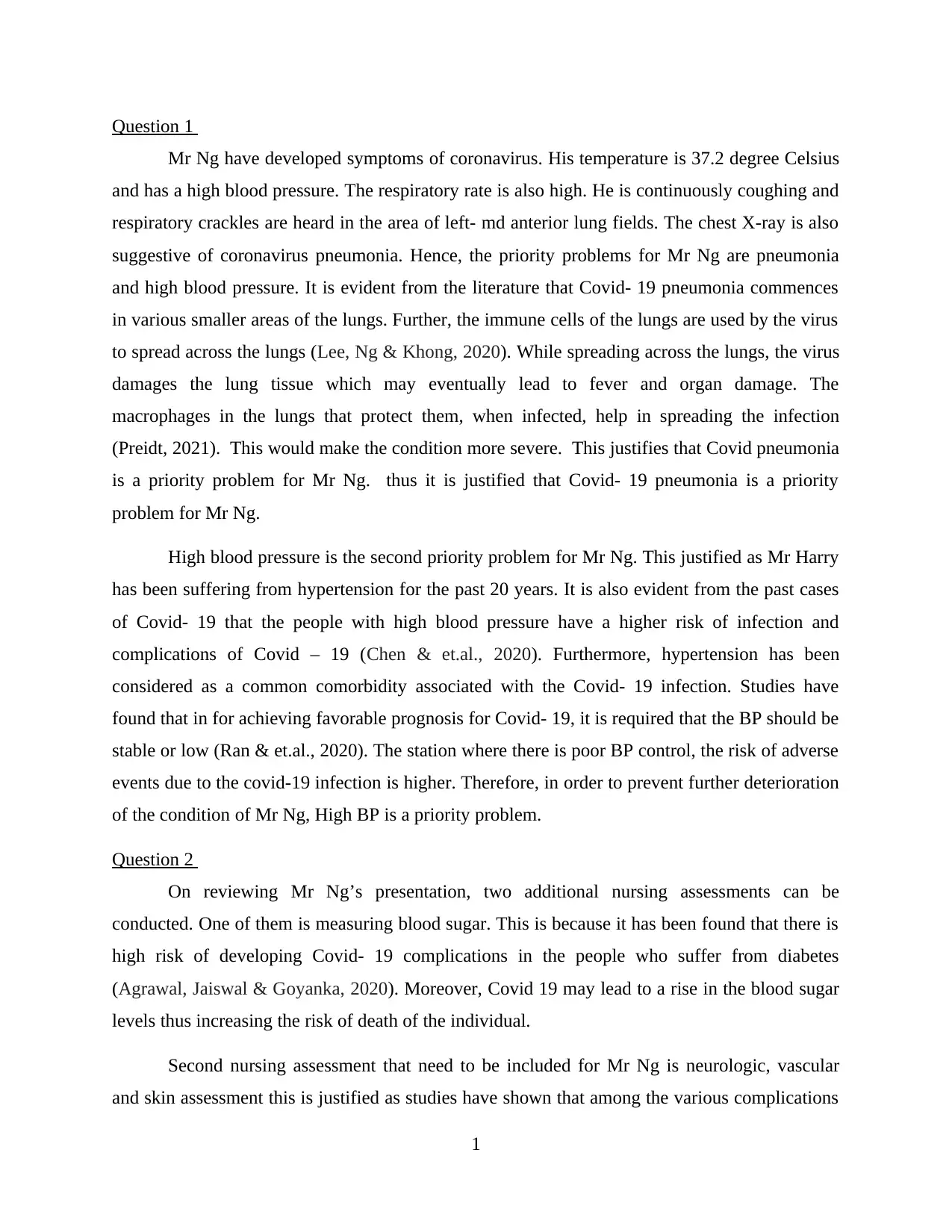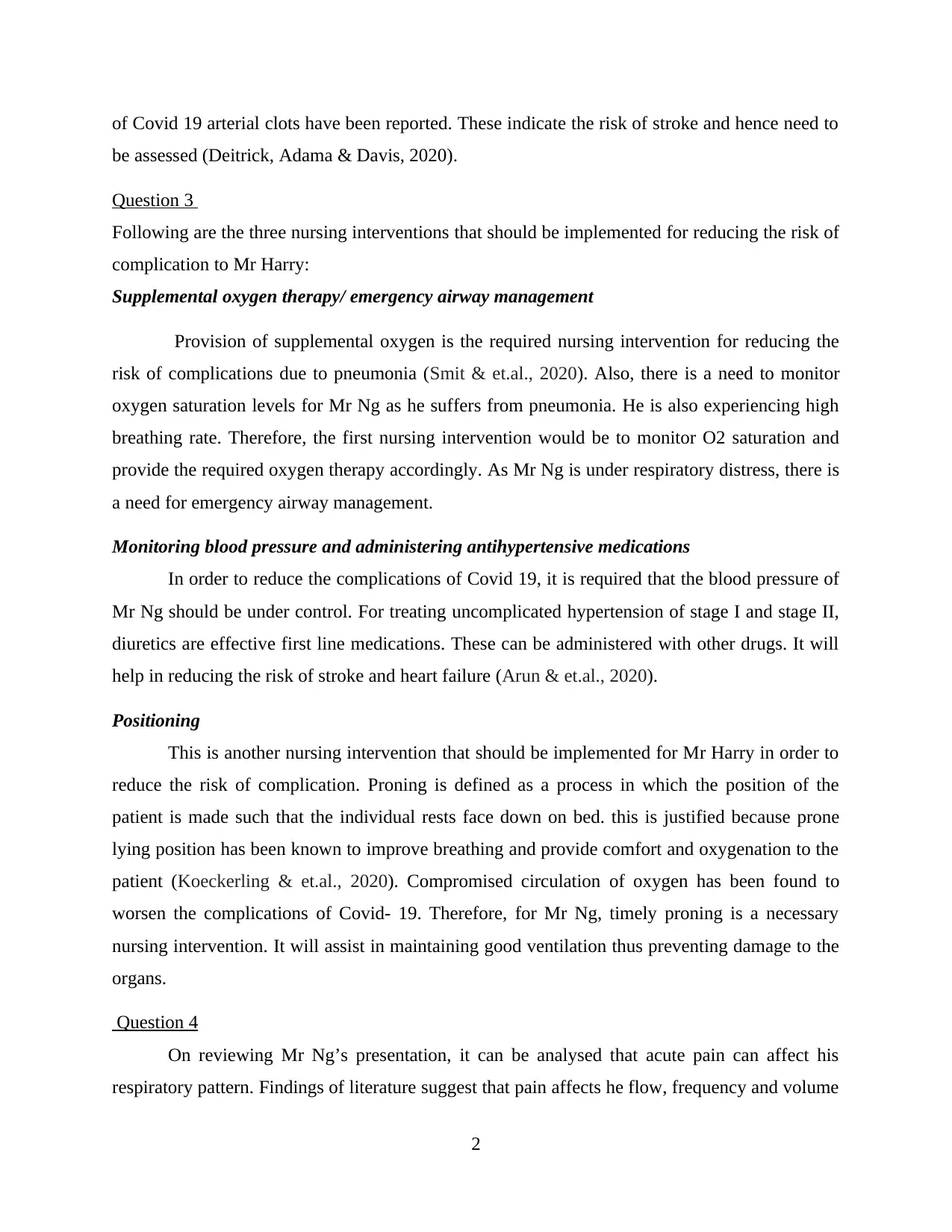Case Study: Prioritizing Care for COVID-19 Pneumonia and Hypertension
VerifiedAdded on 2023/06/18
|5
|1544
|372
Case Study
AI Summary
This case study presents the case of Mr. Ng, who exhibits symptoms of coronavirus, including pneumonia and high blood pressure. It identifies pneumonia and hypertension as priority problems, supported by literature on COVID-19 complications and comorbidities. Additional nursing assessments, such as measuring blood sugar and neurological status, are recommended. Key nursing interventions include supplemental oxygen therapy, blood pressure monitoring, antihypertensive medication administration, and proning. The study also addresses the impact of acute pain on respiratory patterns and suggests relaxation techniques and mindfulness to alleviate anxiety. This document is available on Desklib, a platform offering a range of study tools and solved assignments for students.

ACUTE B Part 1
Mr NG CASE STUDY
Mr NG CASE STUDY
Paraphrase This Document
Need a fresh take? Get an instant paraphrase of this document with our AI Paraphraser

Question 1
Mr Ng have developed symptoms of coronavirus. His temperature is 37.2 degree Celsius
and has a high blood pressure. The respiratory rate is also high. He is continuously coughing and
respiratory crackles are heard in the area of left- md anterior lung fields. The chest X-ray is also
suggestive of coronavirus pneumonia. Hence, the priority problems for Mr Ng are pneumonia
and high blood pressure. It is evident from the literature that Covid- 19 pneumonia commences
in various smaller areas of the lungs. Further, the immune cells of the lungs are used by the virus
to spread across the lungs (Lee, Ng & Khong, 2020). While spreading across the lungs, the virus
damages the lung tissue which may eventually lead to fever and organ damage. The
macrophages in the lungs that protect them, when infected, help in spreading the infection
(Preidt, 2021). This would make the condition more severe. This justifies that Covid pneumonia
is a priority problem for Mr Ng. thus it is justified that Covid- 19 pneumonia is a priority
problem for Mr Ng.
High blood pressure is the second priority problem for Mr Ng. This justified as Mr Harry
has been suffering from hypertension for the past 20 years. It is also evident from the past cases
of Covid- 19 that the people with high blood pressure have a higher risk of infection and
complications of Covid – 19 (Chen & et.al., 2020). Furthermore, hypertension has been
considered as a common comorbidity associated with the Covid- 19 infection. Studies have
found that in for achieving favorable prognosis for Covid- 19, it is required that the BP should be
stable or low (Ran & et.al., 2020). The station where there is poor BP control, the risk of adverse
events due to the covid-19 infection is higher. Therefore, in order to prevent further deterioration
of the condition of Mr Ng, High BP is a priority problem.
Question 2
On reviewing Mr Ng’s presentation, two additional nursing assessments can be
conducted. One of them is measuring blood sugar. This is because it has been found that there is
high risk of developing Covid- 19 complications in the people who suffer from diabetes
(Agrawal, Jaiswal & Goyanka, 2020). Moreover, Covid 19 may lead to a rise in the blood sugar
levels thus increasing the risk of death of the individual.
Second nursing assessment that need to be included for Mr Ng is neurologic, vascular
and skin assessment this is justified as studies have shown that among the various complications
1
Mr Ng have developed symptoms of coronavirus. His temperature is 37.2 degree Celsius
and has a high blood pressure. The respiratory rate is also high. He is continuously coughing and
respiratory crackles are heard in the area of left- md anterior lung fields. The chest X-ray is also
suggestive of coronavirus pneumonia. Hence, the priority problems for Mr Ng are pneumonia
and high blood pressure. It is evident from the literature that Covid- 19 pneumonia commences
in various smaller areas of the lungs. Further, the immune cells of the lungs are used by the virus
to spread across the lungs (Lee, Ng & Khong, 2020). While spreading across the lungs, the virus
damages the lung tissue which may eventually lead to fever and organ damage. The
macrophages in the lungs that protect them, when infected, help in spreading the infection
(Preidt, 2021). This would make the condition more severe. This justifies that Covid pneumonia
is a priority problem for Mr Ng. thus it is justified that Covid- 19 pneumonia is a priority
problem for Mr Ng.
High blood pressure is the second priority problem for Mr Ng. This justified as Mr Harry
has been suffering from hypertension for the past 20 years. It is also evident from the past cases
of Covid- 19 that the people with high blood pressure have a higher risk of infection and
complications of Covid – 19 (Chen & et.al., 2020). Furthermore, hypertension has been
considered as a common comorbidity associated with the Covid- 19 infection. Studies have
found that in for achieving favorable prognosis for Covid- 19, it is required that the BP should be
stable or low (Ran & et.al., 2020). The station where there is poor BP control, the risk of adverse
events due to the covid-19 infection is higher. Therefore, in order to prevent further deterioration
of the condition of Mr Ng, High BP is a priority problem.
Question 2
On reviewing Mr Ng’s presentation, two additional nursing assessments can be
conducted. One of them is measuring blood sugar. This is because it has been found that there is
high risk of developing Covid- 19 complications in the people who suffer from diabetes
(Agrawal, Jaiswal & Goyanka, 2020). Moreover, Covid 19 may lead to a rise in the blood sugar
levels thus increasing the risk of death of the individual.
Second nursing assessment that need to be included for Mr Ng is neurologic, vascular
and skin assessment this is justified as studies have shown that among the various complications
1

of Covid 19 arterial clots have been reported. These indicate the risk of stroke and hence need to
be assessed (Deitrick, Adama & Davis, 2020).
Question 3
Following are the three nursing interventions that should be implemented for reducing the risk of
complication to Mr Harry:
Supplemental oxygen therapy/ emergency airway management
Provision of supplemental oxygen is the required nursing intervention for reducing the
risk of complications due to pneumonia (Smit & et.al., 2020). Also, there is a need to monitor
oxygen saturation levels for Mr Ng as he suffers from pneumonia. He is also experiencing high
breathing rate. Therefore, the first nursing intervention would be to monitor O2 saturation and
provide the required oxygen therapy accordingly. As Mr Ng is under respiratory distress, there is
a need for emergency airway management.
Monitoring blood pressure and administering antihypertensive medications
In order to reduce the complications of Covid 19, it is required that the blood pressure of
Mr Ng should be under control. For treating uncomplicated hypertension of stage I and stage II,
diuretics are effective first line medications. These can be administered with other drugs. It will
help in reducing the risk of stroke and heart failure (Arun & et.al., 2020).
Positioning
This is another nursing intervention that should be implemented for Mr Harry in order to
reduce the risk of complication. Proning is defined as a process in which the position of the
patient is made such that the individual rests face down on bed. this is justified because prone
lying position has been known to improve breathing and provide comfort and oxygenation to the
patient (Koeckerling & et.al., 2020). Compromised circulation of oxygen has been found to
worsen the complications of Covid- 19. Therefore, for Mr Ng, timely proning is a necessary
nursing intervention. It will assist in maintaining good ventilation thus preventing damage to the
organs.
Question 4
On reviewing Mr Ng’s presentation, it can be analysed that acute pain can affect his
respiratory pattern. Findings of literature suggest that pain affects he flow, frequency and volume
2
be assessed (Deitrick, Adama & Davis, 2020).
Question 3
Following are the three nursing interventions that should be implemented for reducing the risk of
complication to Mr Harry:
Supplemental oxygen therapy/ emergency airway management
Provision of supplemental oxygen is the required nursing intervention for reducing the
risk of complications due to pneumonia (Smit & et.al., 2020). Also, there is a need to monitor
oxygen saturation levels for Mr Ng as he suffers from pneumonia. He is also experiencing high
breathing rate. Therefore, the first nursing intervention would be to monitor O2 saturation and
provide the required oxygen therapy accordingly. As Mr Ng is under respiratory distress, there is
a need for emergency airway management.
Monitoring blood pressure and administering antihypertensive medications
In order to reduce the complications of Covid 19, it is required that the blood pressure of
Mr Ng should be under control. For treating uncomplicated hypertension of stage I and stage II,
diuretics are effective first line medications. These can be administered with other drugs. It will
help in reducing the risk of stroke and heart failure (Arun & et.al., 2020).
Positioning
This is another nursing intervention that should be implemented for Mr Harry in order to
reduce the risk of complication. Proning is defined as a process in which the position of the
patient is made such that the individual rests face down on bed. this is justified because prone
lying position has been known to improve breathing and provide comfort and oxygenation to the
patient (Koeckerling & et.al., 2020). Compromised circulation of oxygen has been found to
worsen the complications of Covid- 19. Therefore, for Mr Ng, timely proning is a necessary
nursing intervention. It will assist in maintaining good ventilation thus preventing damage to the
organs.
Question 4
On reviewing Mr Ng’s presentation, it can be analysed that acute pain can affect his
respiratory pattern. Findings of literature suggest that pain affects he flow, frequency and volume
2
⊘ This is a preview!⊘
Do you want full access?
Subscribe today to unlock all pages.

Trusted by 1+ million students worldwide

of respiration (Jafari & et.al., 2017). If the patient is experiencing unrelieved pain, it can make
him limit the movement of the thoracic and abdominal muscles in order to reduce the pain. As a
result of this, respiratory dysfunction may be caused due to retaining of sputum as well as
secretions as the patient becomes reluctant to cough. It may further increase the risk of
pneumonia and atelectasis. The second effect of acute pain on respiratory system is that pain
leads to reduction in the viral lung capacity. This eventually results in increase in inspiratory and
expiratory pressures. These events further lead to reduced alveolar ventilation.
Question 5
Various nursing interventions can be adopted to alleviate anxiety that is being
experienced by Mr Ng. These include relaxation techniques and mindfulness. The relaxation
techniques will involve deep breathing exercises and positive self – talk. Positive visualization
can also be implemented to relive anxiety experienced by Mr Ng. this is justified because when
new coping methods are used, it facilitates the patient to relieve anxiety by using a number of
ways.
Mindfulness can be adopted through mindful breathing and meditation (Rodrigues, Nardi
& Levitan, 2017). This is justified as Mindful breathing will assist in bringing the awareness of
Mr Ng to his breathing pattern which can then be modified to relive stress and anxiety. Through
meditation, anxiety will be relieved as the positive thoughts will be directed towards self and
family members. This will help in making the mindset positive and calming the patient.
3
him limit the movement of the thoracic and abdominal muscles in order to reduce the pain. As a
result of this, respiratory dysfunction may be caused due to retaining of sputum as well as
secretions as the patient becomes reluctant to cough. It may further increase the risk of
pneumonia and atelectasis. The second effect of acute pain on respiratory system is that pain
leads to reduction in the viral lung capacity. This eventually results in increase in inspiratory and
expiratory pressures. These events further lead to reduced alveolar ventilation.
Question 5
Various nursing interventions can be adopted to alleviate anxiety that is being
experienced by Mr Ng. These include relaxation techniques and mindfulness. The relaxation
techniques will involve deep breathing exercises and positive self – talk. Positive visualization
can also be implemented to relive anxiety experienced by Mr Ng. this is justified because when
new coping methods are used, it facilitates the patient to relieve anxiety by using a number of
ways.
Mindfulness can be adopted through mindful breathing and meditation (Rodrigues, Nardi
& Levitan, 2017). This is justified as Mindful breathing will assist in bringing the awareness of
Mr Ng to his breathing pattern which can then be modified to relive stress and anxiety. Through
meditation, anxiety will be relieved as the positive thoughts will be directed towards self and
family members. This will help in making the mindset positive and calming the patient.
3
Paraphrase This Document
Need a fresh take? Get an instant paraphrase of this document with our AI Paraphraser

REFERENCES
Journals and Books
Agrawal, D., Jaiswal, P., & Goyanka, B. (2020). Diabetes and covid-19: A
review. International Journal of Research in Pharmaceutical Sciences, 11(Special Issue
1).
Arun, M. & et.al., (2020). Detection and monitoring of the asymptotic COVID-19 patients using
IoT devices and sensors. International Journal of Pervasive Computing and
Communications.
Chen, R. & et.al., (2020). Influence of blood pressure control and application of renin‐
angiotensin‐aldosterone system inhibitors on the outcomes in COVID‐19 patients with
hypertension. The Journal of Clinical Hypertension, 22(11), 1974-1983.
Deitrick, K., Adama, J. & Davis, J., (2020). Emergency Nursing Care of Patients With Novel
Coronavirus Disease 2019. J Emerg Nurs, 46(6), 748–759.
Jafari, H. & et.al., (2017). Pain and respiration: a systematic review. Pain, 158(6), 995-1006.
Koeckerling, D. & et.al., (2020). Awake prone positioning in COVID-19. Thorax, 75(10), 833-
834.
Lee, E. Y., Ng, M. Y., & Khong, P. L. (2020). COVID-19 pneumonia: what has CT taught
us?. The Lancet Infectious Diseases, 20(4), 384-385.
Ran, J. & et.al., (2020). Blood pressure control and adverse outcomes of COVID-19 infection in
patients with concomitant hypertension in Wuhan, China. Hypertens Res, 43, 1267–1276
Rodrigues, M. F., Nardi, A. E., & Levitan, M. (2017). Mindfulness in mood and anxiety
disorders: a review of the literature. Trends in psychiatry and psychotherapy, 39, 207-
215.
Smit, F. E. & et.al., (2020). Supplemental oxygen therapy in COVID-19. SA Heart, 17(3), 324-
328.
Online
Preidt, R., (2021). Research Shows Why COVID Pneumonia Is More Deadly. [Online].
Available Through: <https://www.webmd.com/lung/news/20210112/research-reveals-
why-covid-pneumonia-is-more-deadly>. [Accessed on 23 July 2021].
4
Journals and Books
Agrawal, D., Jaiswal, P., & Goyanka, B. (2020). Diabetes and covid-19: A
review. International Journal of Research in Pharmaceutical Sciences, 11(Special Issue
1).
Arun, M. & et.al., (2020). Detection and monitoring of the asymptotic COVID-19 patients using
IoT devices and sensors. International Journal of Pervasive Computing and
Communications.
Chen, R. & et.al., (2020). Influence of blood pressure control and application of renin‐
angiotensin‐aldosterone system inhibitors on the outcomes in COVID‐19 patients with
hypertension. The Journal of Clinical Hypertension, 22(11), 1974-1983.
Deitrick, K., Adama, J. & Davis, J., (2020). Emergency Nursing Care of Patients With Novel
Coronavirus Disease 2019. J Emerg Nurs, 46(6), 748–759.
Jafari, H. & et.al., (2017). Pain and respiration: a systematic review. Pain, 158(6), 995-1006.
Koeckerling, D. & et.al., (2020). Awake prone positioning in COVID-19. Thorax, 75(10), 833-
834.
Lee, E. Y., Ng, M. Y., & Khong, P. L. (2020). COVID-19 pneumonia: what has CT taught
us?. The Lancet Infectious Diseases, 20(4), 384-385.
Ran, J. & et.al., (2020). Blood pressure control and adverse outcomes of COVID-19 infection in
patients with concomitant hypertension in Wuhan, China. Hypertens Res, 43, 1267–1276
Rodrigues, M. F., Nardi, A. E., & Levitan, M. (2017). Mindfulness in mood and anxiety
disorders: a review of the literature. Trends in psychiatry and psychotherapy, 39, 207-
215.
Smit, F. E. & et.al., (2020). Supplemental oxygen therapy in COVID-19. SA Heart, 17(3), 324-
328.
Online
Preidt, R., (2021). Research Shows Why COVID Pneumonia Is More Deadly. [Online].
Available Through: <https://www.webmd.com/lung/news/20210112/research-reveals-
why-covid-pneumonia-is-more-deadly>. [Accessed on 23 July 2021].
4
1 out of 5
Related Documents
Your All-in-One AI-Powered Toolkit for Academic Success.
+13062052269
info@desklib.com
Available 24*7 on WhatsApp / Email
![[object Object]](/_next/static/media/star-bottom.7253800d.svg)
Unlock your academic potential
Copyright © 2020–2025 A2Z Services. All Rights Reserved. Developed and managed by ZUCOL.





